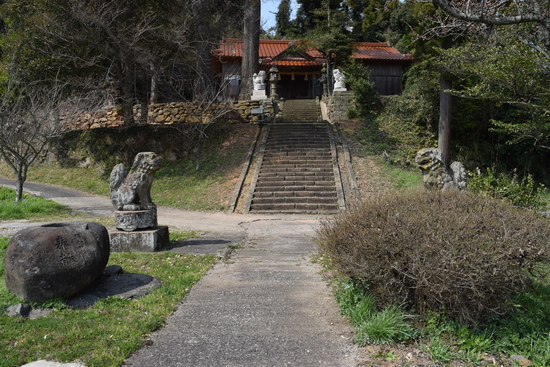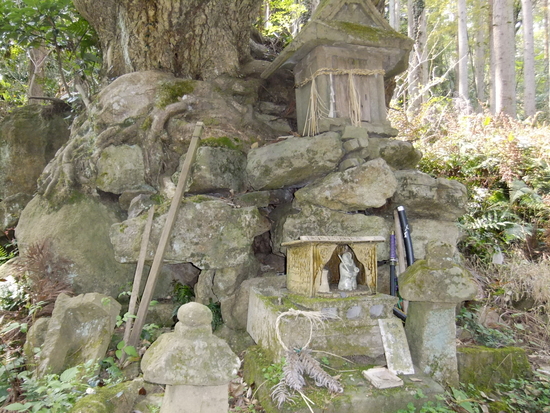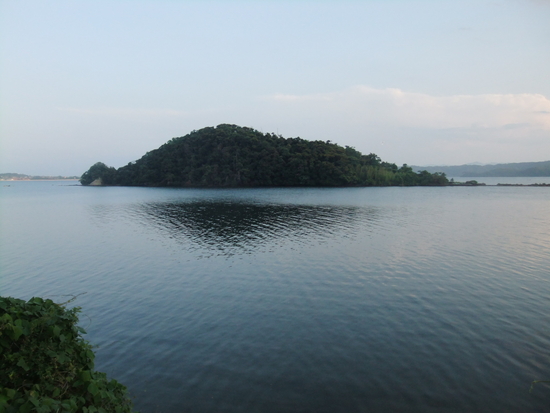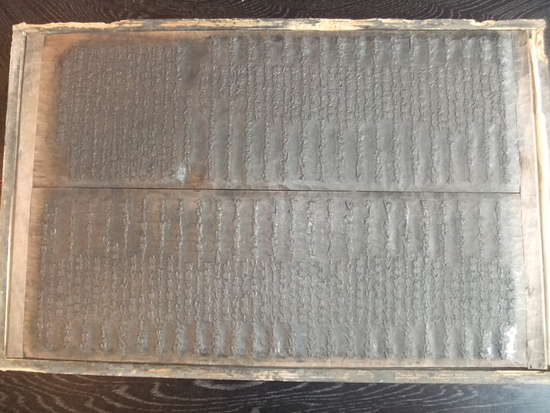Nagami-jinja
| Shrine Name | Nagami-jinja |
|---|---|
| Deity |
Ninigi-no-mikoto Konohanasakuyahime |
| Location | Matsue-shi Nagami-cho 51 |

Local village shrine, Nagami-jinja is neatly enshrined north of Nagami river in Nagami-cho, Matsue city. Although the Izumo Fudoki is unfortunately incomplete with the names of five shrines unaccounted for, as luck would have it, there is an article mentioning Nagami-jinja in the Heian period Engishi records. The Fudoki does mention a Nagami river, so theoretically, it can probably be assumed that there was a shrine there during the Nara Period. However, it seems more appropriate in terms of geographical environment and location in front of the shore that instead of Nagaumi (long view), that 'nakami' (long sea) may be a more fitting name. Perhaps history being a little mischievous?
The shrine is mentioned in both the official shrine records and pilgrimage journal , although in the Edo period, it went by the name Kita-jinja. The official shrine history explains, "This shrine started in Sakitadani and established a Ookami (God) with Kita-jinja, perhaps the 'kita' comes from the name within Sakitadani? There is still a Sakita name in old local address formats and Bunsei Era (1818=1830) village maps mention a 'forest shrine' in Sakita-most probably this is the Nagami jinja of the Edo Period.
In addition, while it remains unclear, there are said to be handwritten sentences by warrior monk Benkei in Nagami-jinja. In the Meiji period 'Yatsuka gun shrine records', there is mention of a shrine within Nagami-jinja's grounds dedicated to the mother of Benkei called 'Benkichijyoreisha'. This was formerly in Benkei Forest and moved to Nagami shrine in Meiji 12 but there are doubts surrounding the legend of Benkei and a strong possibility that Benkichijyoreisha had to be replaced as Wakamiya shrine. However in a Yatsuka periodical from Meiji 48, there is reference to , " A small shrine called Benkichijyoreisha within the precinct of Nagami shrine." Without a doubt, where there is smoke, there is fire, so there is a definite need to review and carefully reconsider the legend once more. Furthermore, there is also a need for more knowledge about the birthplace of the 42 bay pilgrimage, Benkei, his own birth, and how Benkichijyoreisha came to be enshrined here.

There are many historical sites and legends related to Benkei around the Honjo-cho area of Matsue city. Northeast of Nagami shrine is Benkei Forest, where he was born and raised. Legend has it that this area also has traces of the well dug by his mother Benkichi to supply water for his first post-birth bath. This is also the location of the Benkichijyoreisha, which enshrines Benkichi. This spot is the basis for the Benkichijyoreisha festival, an event held every July 1st by Nagami shrine parishioners. It is an memorial event honoring the journey at great length from Wakayama prefecture to Nagami, the birth of Benkei.
In recent years, signposts have been put up near the entrance to Benkei Forest. Entering from the left side of the road and following the square kimachi paving stones leads to the entrance of some cedar tree woods . The Benkichijyoreisha can be found at the foot of a large chinquapin tree adorned with various offerings such as a naginata long sword (as used by Benkei) and ceramic house with a figure of Benkei inside.
A rough character, Benkei nevertheless served nobleman Minamoto no Yoshitsune until defeat at the Siege of Koromogawa, or 'Benkei's last stand'. Even today, there can be worshippers found here praying for good fortune and a safe birth to the mother who bore and raised the vigorous, robust Benkei. formerly, there were rice paddies within the shrine precincts along with a drinking spot said to be the source of the water Benkichi used to first bathe her son. I have heard that there used to be a 28m² temple often visited by pregnant women, too. It is said that local ladies used to gather, weed the grass, and use the place as a spot for drinking tea.
Benkei was a wayward youth and being hard to keep a handle on, his behavior led to him being banished to Benkei Island. While there, there was flooding to the west of Kezoji temple on the left of the first torii gate on the road approaching the shrine . Legend has it that Benkei actually joined forces with the villagers in sorting out the stones that had been scattered by the deluge, an early example of his efforts even before starting genuine aesthetic practices.
These practices officially began when Benkei was 18 at Gakuenji temple in Gakuen town, Izumo. It is said that while there, he spent a night at Daisenji temple in Tottori prefecture and brought back a large bell from there. This legend is celebrated at the 'Musashibo Matsuri' at Gakuenji in the former Hirata town in the west of the Shimane peninsular.
In the storage area of Nagami shrine are papers detailing the life of Benkei and that of his mother. These include various legends including that from Okidomari , Shimane machi, Matsue where he is said to have cured an eye ailment by cleansing with sea water . These documents record details up to when Benkei visited Kii province (now Wakayama prefecture) as part of his province to province ascetic monk practice upon completing his three years at Gakuenji and his meeting with Minamoto no Yoshitsune.
In Yatsuka town, south of Honjo, Matsue city there are wooden carvings of the 42 Bay pilgrimage book of verses. Within these is reference to 'Saito Musashibo Benkei'. It is not known exactly why that is here, but it is not unusual considering the various connections Benkei has to this area and it serves as an important document connecting him to the 42 bay pilgrimage.



| Shrine Name | Nagami-jinja |
|---|---|
| Deity |
Ninigi-no-mikoto Konohanasakuyahime |
| Location | Matsue-shi Nagami-cho 51 |
Local village shrine, Nagami-jinja is neatly enshrined north of Nagami river in Nagami-cho, Matsue city. Although the Izumo Fudoki is unfortunately incomplete with the names of five shrines unaccounted for, as luck would have it, there is an article mentioning Nagami-jinja in the Heian period Engishi records. The Fudoki does mention a Nagami river, so theoretically, it can probably be assumed that there was a shrine there during the Nara Period. However, it seems more appropriate in terms of geographical environment and location in front of the shore that instead of Nagaumi (long view), that 'nakami' (long sea) may be a more fitting name. Perhaps history being a little mischievous?
The shrine is mentioned in both the official shrine records and pilgrimage journal , although in the Edo period, it went by the name Kita-jinja. The official shrine history explains, "This shrine started in Sakitadani and established a Ookami (God) with Kita-jinja, perhaps the 'kita' comes from the name within Sakitadani? There is still a Sakita name in old local address formats and Bunsei Era (1818=1830) village maps mention a 'forest shrine' in Sakita-most probably this is the Nagami jinja of the Edo Period.
In addition, while it remains unclear, there are said to be handwritten sentences by warrior monk Benkei in Nagami-jinja. In the Meiji period 'Yatsuka gun shrine records', there is mention of a shrine within Nagami-jinja's grounds dedicated to the mother of Benkei called 'Benkichijyoreisha'. This was formerly in Benkei Forest and moved to Nagami shrine in Meiji 12 but there are doubts surrounding the legend of Benkei and a strong possibility that Benkichijyoreisha had to be replaced as Wakamiya shrine. However in a Yatsuka periodical from Meiji 48, there is reference to , " A small shrine called Benkichijyoreisha within the precinct of Nagami shrine." Without a doubt, where there is smoke, there is fire, so there is a definite need to review and carefully reconsider the legend once more. Furthermore, there is also a need for more knowledge about the birthplace of the 42 bay pilgrimage, Benkei, his own birth, and how Benkichijyoreisha came to be enshrined here.
There are many historical sites and legends related to Benkei around the Honjo-cho area of Matsue city. Northeast of Nagami shrine is Benkei Forest, where he was born and raised. Legend has it that this area also has traces of the well dug by his mother Benkichi to supply water for his first post-birth bath. This is also the location of the Benkichijyoreisha, which enshrines Benkichi. This spot is the basis for the Benkichijyoreisha festival, an event held every July 1st by Nagami shrine parishioners. It is an memorial event honoring the journey at great length from Wakayama prefecture to Nagami, the birth of Benkei.
In recent years, signposts have been put up near the entrance to Benkei Forest. Entering from the left side of the road and following the square kimachi paving stones leads to the entrance of some cedar tree woods . The Benkichijyoreisha can be found at the foot of a large chinquapin tree adorned with various offerings such as a naginata long sword (as used by Benkei) and ceramic house with a figure of Benkei inside.
A rough character, Benkei nevertheless served nobleman Minamoto no Yoshitsune until defeat at the Siege of Koromogawa, or 'Benkei's last stand'. Even today, there can be worshippers found here praying for good fortune and a safe birth to the mother who bore and raised the vigorous, robust Benkei. formerly, there were rice paddies within the shrine precincts along with a drinking spot said to be the source of the water Benkichi used to first bathe her son. I have heard that there used to be a 28m² temple often visited by pregnant women, too. It is said that local ladies used to gather, weed the grass, and use the place as a spot for drinking tea.
Benkei was a wayward youth and being hard to keep a handle on, his behavior led to him being banished to Benkei Island. While there, there was flooding to the west of Kezoji temple on the left of the first torii gate on the road approaching the shrine . Legend has it that Benkei actually joined forces with the villagers in sorting out the stones that had been scattered by the deluge, an early example of his efforts even before starting genuine aesthetic practices.
These practices officially began when Benkei was 18 at Gakuenji temple in Gakuen town, Izumo. It is said that while there, he spent a night at Daisenji temple in Tottori prefecture and brought back a large bell from there. This legend is celebrated at the 'Musashibo Matsuri' at Gakuenji in the former Hirata town in the west of the Shimane peninsular.
In the storage area of Nagami shrine are papers detailing the life of Benkei and that of his mother. These include various legends including that from Okidomari , Shimane machi, Matsue where he is said to have cured an eye ailment by cleansing with sea water . These documents record details up to when Benkei visited Kii province (now Wakayama prefecture) as part of his province to province ascetic monk practice upon completing his three years at Gakuenji and his meeting with Minamoto no Yoshitsune.
In Yatsuka town, south of Honjo, Matsue city there are wooden carvings of the 42 Bay pilgrimage book of verses. Within these is reference to 'Saito Musashibo Benkei'. It is not known exactly why that is here, but it is not unusual considering the various connections Benkei has to this area and it serves as an important document connecting him to the 42 bay pilgrimage.






